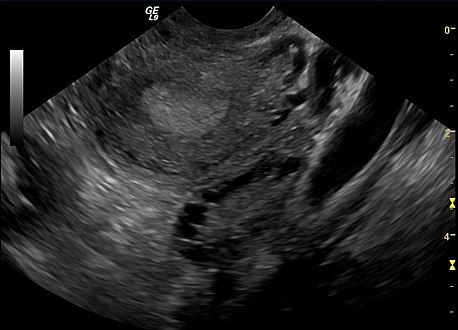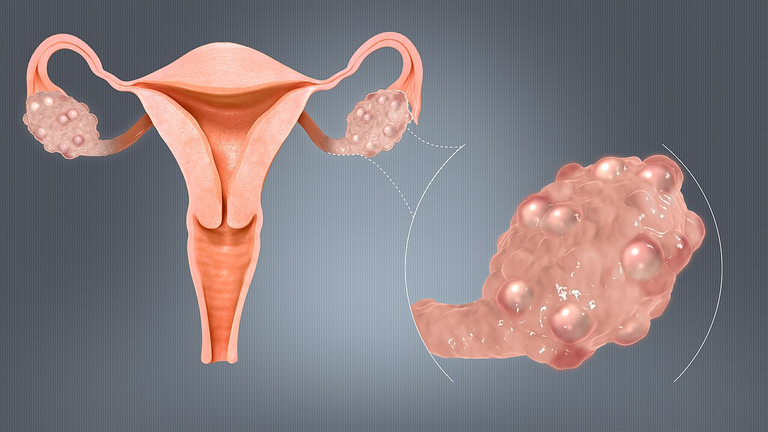POLYCYSTIC OVARIAN SYNDROME

source: Wikimedia
Introduction/Definition
Polycystic ovarian syndrome, also known as PCOS , is a common health problem that affects 1 in 10 women and 1 in every black woman. It is an heterogeneous disorder caused by an imbalance of reproductive hormones. It is characterized by excessive androgen production particularly from the ovaries.
This excessive androgen production creates problems in the ovaries. The ovaries produce the ova/egg that is released in each menstrual cycle. This function of the ovary is impaired in PCOS. This leads to irregular menstrual periods leading to infertility
in women
Epidemiology
PCOS mainly affects women of reproductive age groups is between 15 and 45 years. Although most women are diagnosed in their 20s or 30s when they're ready for childbirth and are having issues with getting pregnant
Although, PCOS affects all races and ethnicities, it is more common among African women.
Obesity and Family predilection are risk factors of getting PCOS
Symptoms
Polycystic ovarian syndrome (PCOS) was originally described in 1935 by Stein and Leventhal as a heterogeneous syndrome characterized by amenorrhea (irregular or absent menstruation), hirsutism (male hair pattern) and obesity associated with enlarged polycystic ovaries.
Some of the symptoms of PCOS include:
- Irregular menstrual cycle: They usually present with missed periods which are usually less than 8 times per year. Some even stop seeing their period.
- Hirsutism: This is described as male pattern of hair destribution seen in women. They have plenty hair on their face, chin and chest
- Severe acne on the face, chest, and upper back
- Male pattern baldness
- Weight gain (esp abdominal obesity) and difficulty in losing weight
- Acanthosis nigricans: Thickened and Pigmented skin particularly along neck creases, inner thighs, groin, armpit and underneath breasts
- Skin tags, which are small excess flaps of skin in the armpits or neck area
Diagnosis
Apart from the symptoms and features seen in these patients. Some investigations are made and PCOS is diagnosed when a woman comes down with any two of the following three

Polycystic Ovaries : These is seen when pelvic sonography or transvaginal sonography(for obese women) is done. The ovaries seen are usually bigger than normal >10cm3, also there are multiple ovarian follicular cysts usually more than 12 each between 2-9mm in size.
Hyperandrogenism: This is simply excess androgen production especially by the ovaries and can be seen with the symptoms they present with such as irregular periods, hirsutism, male pattern baldness. Excessive androgen production can be further confirmed by the blood work. The male hormones testosterone is markedly raised in these women
Oligo or Anovulation: This simply means fewer or complete cessation of ovulation. This occurs as a result of the excess androgen hormones being secreted by the ovaries. It inhibits the production of ovum/egg from the ovaries. This leads to the irregular menses or even complete stoppage of the menses and eventually infertility
Aetiology
The exact cause of PCOS is unknown. However PCOS is a multifactorial and polygenic condition.

We would attempt to explain the symptoms
Excessive Androgens: Androgens are called male hormones, although women produce them in little quantities. It is mainly found in men, this is what gives the male secondary sexual traits such as hair growth on the face and chest and the male pattern baldness. As discussed earlier, the ovaries in women with PCOS produce more androgens than is necessary. This prevents ovulation and results in the hair loss and male pattern of hair distribution seen in these women
Insulin resistance: insulin is an hormone that controls blood sugar. In women with PCOS, the body doesn't respond to the insulin secreted in the blood. The causes higher levels of insulin in the blood. This is mostly seen in overweight or obese women. Over time this insulin resistance results in diabetes as the blood sugar level is increased
Anovulation: The eggs produced by the ovaries in PCOS do not attain maturity. Their growth is truncated at different phases of maturity that is why their size is between 2-10mm in diameter. This occurs due to the reduced Follicle Stimulating Hormone produce by the brain. The net result is that the eggs do not mature beyond a certain poin and ovulation does not occur
Management
Treatment of PCOS is usually individualized depending on the patients symptoms. Most time the major complaint is infertility, weight gain and hirsutism
Patient counseling and guidance is vital because they must be interested and motivated
Treatment is targeted to reduce the abnormal hormone secretions

source: Pexels
- Obesity: In obese patients, the first line of management is weight reduction. The target BMI is <25, this often time improves the irregular menstruation, infertility and insulin resistance.
- Excess Androgens: This can be corrected by use of Combined oral contraceptives pills
- insulin resistance: After proper weight reduction, the doctor will prescribe an insulin sensitising medication that will cause the cells to respond to insulin
- Infertility: Ovulation can be induced to achieve fertility. This is usually done by use of clomiphene citrate but all other abnormalities should have been corrected first.
References
- Polycystic Ovaries: Wikipedia
- Dutta's textbook of Gynaecology
- Polycystic Ovary Syndrome: Office on Women's Health